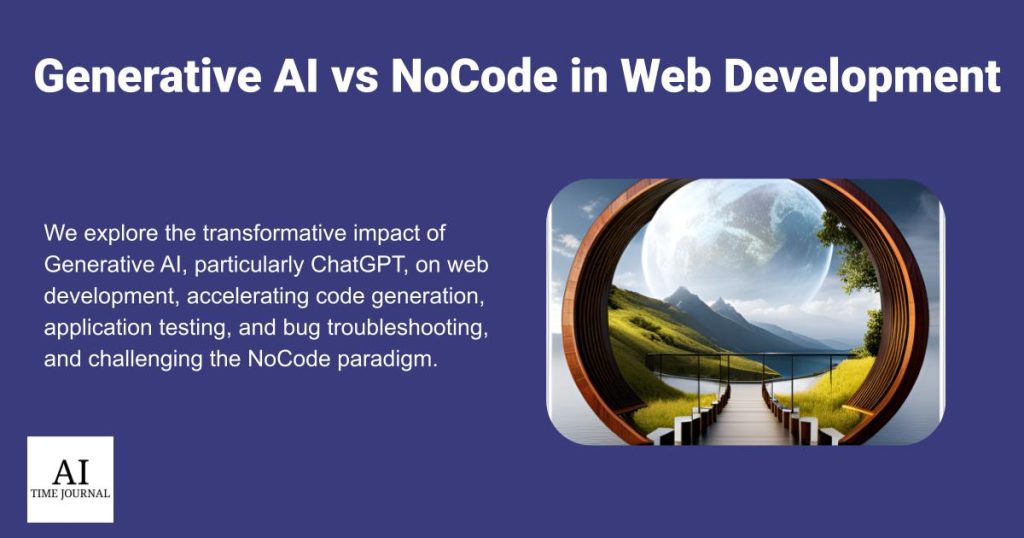
Trends in web development have seen continual refinement and evolution. The battle for supremacy between Generative AI and NoCode platforms is escalating, with each presenting its unique strengths on web development’s main battlegrounds: the backend and the frontend.
The Backend: Generative AI’s Dominance
The backend is the technological infrastructure, the unseen powerhouse that forms the essence of any application or website.
With NoCode, although no manual code typing is needed, you still have to establish a logic for backend operations, typically done by manually configuring a graphical user interface, a type of work that is not equally prone to automation as text generation.
Here, Generative AI has gained significant ground.
The recent introduction of ChatGPT is a great example.
With ChatGPT, a new dawn in web development has emerged, significantly accelerating the overall development time by expediting three critical aspects of web development:
- Code Development: The collaboration between AI and human developers drastically streamlines the process of crafting backend code. This leads to more efficient and quicker code generation, as the power of AI combines with human creativity to create a robust codebase in a fraction of the traditional time.
- Application Testing: The reach of this dynamic collaboration extends even to application testing. With AI-powered tools like ChatGPT, the testing process becomes agile and rapid. Not only can potential issues be identified quicker, but testing code itself can also be automatically generated. This greatly speeds up the testing phase, ensuring thorough, efficient verification of the application’s functionality and robustness.
- Troubleshooting Bugs: Finally, the time-consuming task of troubleshooting and fixing bugs is expedited. ChatGPT’s ability to quickly identify and isolate issues allows developers to focus their time on crafting solutions rather than laboriously searching for the problem.
This AI-powered development paradigm revolutionizes web development, harmoniously blending human creativity with the efficiency and speed of AI. From the initial coding phase to final bug fixes, this approach results in a significantly more efficient development cycle, drastically reducing time-to-market.
The Frontend: NoCode’s Forte, But For How Long?
Frontend, the visual part of any application or website, is where NoCode has traditionally excelled. It allows for rapid UI development, giving developers direct visual feedback through its WYSIWYG (“what you see is what you get”) interface. However, there’s also a changing tide here, with the combination of humans and AI proving increasingly proficient at designing front-end code.
But the most critical question that arises is: in the future, will we even need a GUI for our applications? The traditional need for NoCode, low-code, and WYSIWYG is premised on both the application’s user and creator being human. However, as AI agents increasingly become the users of applications, we could see a shift toward ‘headless’ apps, where automations become the users and a GUI is no longer necessary.
New Paradigms: LangChain and AutoGPT
This leads us to new paradigms in application development, spearheaded by frameworks like LangChain and AutoGPT. These frameworks allow developers to create AI applications that make autonomous decisions and solve complex problems by chaining prompts into a Large Language Model (LLM), such as OpenAI or Google Bard. They can integrate APIs for additional capabilities and use vector databases for memory.
In an AutoGPT demo dated April 16th, 2023, an AI program demonstrated its ability to learn about a new concept (AutoGPT itself in the example) by browsing the Internet, researching, and collecting information. This presents an exciting possibility: applications that can independently learn, evolve, and adapt, symbolizing a shift towards an AI-first development paradigm.
AI-First Applications: The Future?
In this new paradigm, we may no longer need GUIs or if we do, they could be simple chat interfaces where humans can supervise, instruct and talk with the AI agents that do the actual work. The main job of application developers would then become orchestrating LLMs for intelligence, vector databases for memory, and API integrations for additional capabilities.
As Peter Thiel asks in his book, Zero to One, “Can you create breakthrough technology instead of incremental improvements?” This question rings even more true today.
Conclusion
The struggle between Generative AI and NoCode in web development is more than a battle for dominance. It represents a shifting landscape where our approach to building applications is evolving, from a human-centric to an AI-first paradigm. The future might not be about creating more visually appealing GUIs, but about crafting intelligent applications that can learn, adapt, and work autonomously.
Let me know what you think on LinkedIn or contribute to our upcoming eBook on Software Development Trends in 2023.
